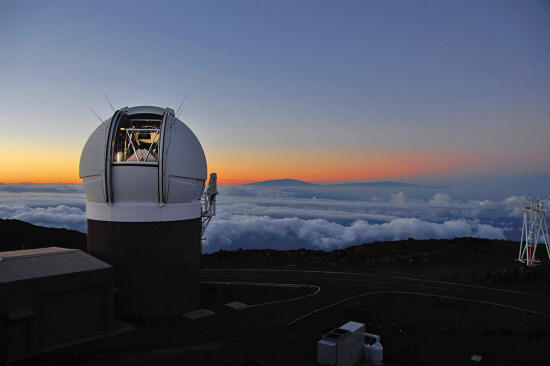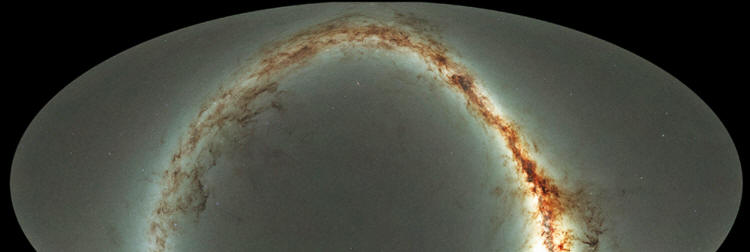|

by
Queen's University Belfast
December 19, 2016
from
PHYS Website

This far below
compressed view of the entire sky visible from
Hawai'i by the Pan-STARRS1 Observatory is the result
of half a million exposures, each about 45 seconds
in length, taken over a period of four years.
The shape comes
from making a map of the celestial sphere, like a
map of the Earth, but leaving out the southern
quarter.
The disk of the
Milky Way looks like a yellow arc, and the dust
lanes show up as reddish brown filaments.
The background
is made up of billions of faint stars and galaxies.
If printed at
full resolution, the image would be 1.5 miles long,
and you would have to get close and squint to see
the detail.
Credit:
Danny Farrow,
Pan-STARRS1 Science Consortium
and Max Planck
Institute for Extraterrestial Physics
The world's largest digital survey of the visible Universe, mapping
billions of stars and galaxies, has been publicly released.
The data has been made available by the international
Pan-STARRS Project, which includes
scientists from Queen's University Belfast, who have predicted that
it will lead to new discoveries about the Universe.
Astronomers and cosmologists used a 1.8-metre telescope at the
summit of
Haleakalā, on Maui, Hawaii, to
repeatedly image three quarters of the visible sky over four years.
Three billion
sources
The data they have captured in the Pan-STARRS1 Surveys is made up of
three billion separate sources, including stars, galaxies, and other
space objects.
This immense collection of information contains two petabytes of
computer data - equivalent to one billion selfies or one hundred
times the total content of Wikipedia.
-
Pan-STARRS is hosted by the
University of Hawaii Institute for Astronomy, which is
releasing the data alongside the Space Telescope Science
Institute in Baltimore, USA.
-
The international collaboration
also includes Queen's University Belfast and the
Universities of Durham and Edinburgh.
-
It is supported by NASA and the
National Science Foundation.
-
Durham's contribution was funded
by a generous donation from the Ogden Trust and Durham
University.
Luminous
distant explosions
Queen's University Belfast Professor Stephen Smartt, who is
Chair of the Pan-STARRS1 (PS1) Science Council, said:
"We've worked on this project for
more than five years at Queen's and have found the most luminous
distant explosions in the Universe and also nearby asteroids in
our solar system.
"It was a fantastic team effort and now we hope the whole
science community will benefit from this public release of our
data."

Pan-STARRS sky
survey.
Image credit:
Pan-STARRS1 Science Consortium.
Digital survey
In May 2010, the Panoramic Survey Telescope & Rapid Response
System, or Pan-STARRS, observatory embarked on a digital survey
of the sky in visible and near infrared light.
This was the first survey with a goal of observing the sky very
rapidly over and over again, looking for moving objects and
transient or variable objects, including asteroids that could
potentially threaten the Earth.
Dr Ken Chambers, Director of the Pan-STARRS Observatories, at
the University of Hawaii, said:
"The Pan-STARRS1 Surveys allow
anyone to access millions of images and use the database and
catalogues containing precision measurements of billions of
stars and galaxies.
"Pan-STARRS has already made discoveries from Near Earth Objects
and Kuiper Belt Objects in the Solar System to lonely planets
between the stars; it has mapped the dust in three dimensions in
our galaxy and found new streams of stars; and it has found new
kinds of exploding stars and distant quasars in the early
Universe."
Static sky
The roll-out of the survey data is being done in two steps.
-
Today's release is the "Static
Sky" which provides an average value for the position,
brightness and color for objects captured in the sky at
individual moments in time.
-
In 2017, a second set of data
will be released including catalogues and images from each
of the individual snapshots that Pan-STARRS took of a given
region of sky.
The data from the Pan-STARRS1 surveys
will be available online at
panstarrs.stsci.edu.
|



